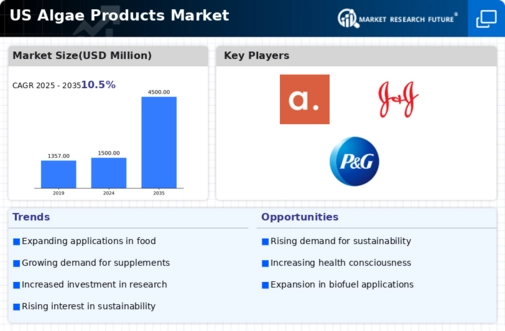Expansion of Algae Applications
the algae products market is expanding in applications across various sectors, including food, cosmetics, and biofuels.. This diversification is driven by the unique properties of algae, which can be utilized in a multitude of ways. In the food industry, algae are being incorporated into health foods, snacks, and beverages, while in cosmetics, they are valued for their moisturizing and anti-aging properties. Additionally, algae are being explored as a sustainable source of biofuels, which could significantly reduce reliance on fossil fuels. As research continues to uncover new applications, the algae products market is likely to experience robust growth. Projections suggest that by 2026, the market could reach approximately $2.5 billion, reflecting the increasing versatility and demand for algae-derived products.
Innovations in Algae Processing
Innovations in processing techniques are playing a pivotal role in the algae products market. Advances in extraction and refinement methods have enhanced the quality and usability of algae-derived products. For instance, improved extraction technologies allow for higher yields of valuable compounds, such as phycocyanin and astaxanthin, which are sought after in the food and cosmetic industries. The algae products market is also witnessing the development of novel formulations that enhance bioavailability and efficacy. As these innovations continue to evolve, they are expected to attract a broader range of industries, including pharmaceuticals and nutraceuticals, further driving market growth. The potential for algae to be utilized in diverse applications may lead to an increase in market value, with estimates suggesting a growth trajectory that could exceed $2 billion by 2027.
Health Benefits of Algae Products
The algae products market is experiencing a surge in interest due to the growing awareness of health benefits associated with algae consumption. Rich in essential nutrients, including omega-3 fatty acids, vitamins, and antioxidants, algae are increasingly recognized for their potential to enhance overall health. Research indicates that incorporating algae into diets may support cardiovascular health and improve immune function. As consumers prioritize health and wellness, the demand for algae-based supplements and food products is likely to rise. In 2025, the market for algae-based dietary supplements in the US is projected to reach approximately $1.5 billion, reflecting a compound annual growth rate (CAGR) of around 8%. This trend underscores the potential of algae products to cater to health-conscious consumers seeking natural and nutrient-dense food options.
Regulatory Support for Algae Products
Regulatory frameworks are increasingly supportive of the algae products market, facilitating growth and innovation. In the US, agencies such as the FDA are establishing guidelines for the safe use of algae in food and dietary supplements. This regulatory clarity is essential for manufacturers, as it helps to ensure product safety and efficacy, thereby boosting consumer confidence. Furthermore, government initiatives aimed at promoting sustainable agricultural practices are likely to favor algae cultivation, given its low environmental impact compared to traditional crops. As regulatory support strengthens, it may lead to an influx of new players in the algae products market, enhancing competition and driving down prices. This supportive environment could potentially increase market penetration, with projections indicating a market size of approximately $1.8 billion by 2026.
Rising Interest in Sustainable Ingredients
The algae products market is benefiting from a rising interest in sustainable ingredients among consumers and manufacturers alike. Algae cultivation requires significantly less land and water compared to conventional crops, making it an attractive alternative for sustainable food production. As consumers become more environmentally conscious, they are increasingly seeking products that align with their values. This shift is prompting food manufacturers to incorporate algae into their formulations, whether in snacks, beverages, or supplements. The market for sustainable food products is expected to grow, with algae playing a crucial role in meeting this demand. By 2025, the algae products market could see a valuation of around $1.2 billion, driven by the increasing preference for eco-friendly and sustainable food sources.














Leave a Comment